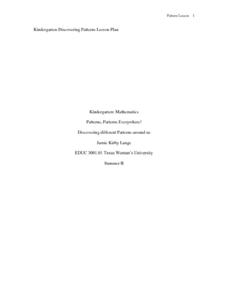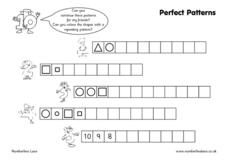Texas Woman’s University
Patterns, Patterns Everywhere!
Not only is pattern recognition an essential skill for young children to develop, it's also a lot of fun to teach! Over the course of this lesson, class members participate in shared readings, perform small group...
Curated OER
Number Patterns
These patterns are perfect for learners brand new to counting. They examine 9 number sequences, completing the last two numbers. The codes are easy to crack here- they count by 1, 2, and 3. For a bonus sequence, scholars count by 10....
Curated OER
Patterns
Follow the pattern to find what comes next. Youngsters analyze shape patterns to continue the sequence in the provided space. The three patterns increase in difficulty, and then scholars have a chance to create two of their own....
K12 Reader
Extending Patterns
2, 4, 6, 8. What comes next? This reading comprehension worksheet discusses patterns and extending patterns. After reading the short article, kids answer a series of questions to demonstrate their understanding of the passage.
Curated OER
Repeating and Growing Patterns homework 6.5
For this continuing the pattern worksheet, students observe patterns, write the numbers, draw the next picture, and identify sequence as a repeating pattern or a growing pattern. Students write four answers.
Curated OER
Math Worksheet: Patterns Again
For this math patterns worksheet, learners see 10 math patterns with repeating geometric shapes. They choose the shape that will come next in the pattern from 3 choices.
Math Salamanders Ltd.
Multiplication As Repeated Addition
In this understanding of multiplication as a repeated addition worksheet, students convert repeated addition facts to multiplication facts and find the products. Students solve 30 problems.
Math Salamanders Ltd.
Multiplication as Repeated Addition to 10x10
The class works to change 15 repeated addition problems into their multiplication counterparts and then completes 15 more where they do the opposite. This is a great way to build an understanding of what multiplication is and could...
Curated OER
Perfect Patterns- Completing Patterns Worksheet
In this completing patterns worksheet, students complete patterns with geometric shapes and the numbers 1-10. They color the geometric shapes with at repeating patterns.
Noyce Foundation
Between the Lines
Explore linear and square dimensions by comparing areas of similar figures. A creative set of five activities designed for elementary through high school classes asks young scholars to compare areas of specific polygons. The first two...
Curated OER
Repeat It challenge
In this recognizing pattern worksheet, students observe sets of patterns, identify the patterns that repeat, and choose the picture that most likely comes next. Students solve five problems.
Curated OER
Make Your Own Pattern
In this early childhood understanding patterns worksheet, students find the pattern in 3 problems and then show each another way. Students also explain how they decided what pattern to make in 1 of the problems.
Curated OER
Recognizing Math Patterns
In this math worksheet students see 10 sets of math patterns. Each pattern is made up of repeating geometric shapes. Students mark the choice which would complete the pattern.
Curated OER
Starfish Surprises
In this missing numbers worksheet, young scholars write the missing numbers covered by the starfish in the patterns. Students complete 6 problems total.
Curated OER
Translating Patterns
In this worksheet, students examine picture patterns which have blank boxes beneath each picture. Students translate the pattern by coloring the boxes. Example: rose, rose, bird, rose, rose. (red, red, blue, red, red).
Curated OER
Counting to 100: Step-by-Step
Introduce your pupils to the hundreds chart! This pair of worksheets is designed to walk them through the patterns they see in the chart as they count by ones and 10s. They fill in missing numbers on a hundreds chart, using guided steps....
Curated OER
Relate Counting to Addition and Subtraction
Use patterns to practice basic addition; pupils count by two, starting from eight and counting on to 20. They record the five numbers missing from the sequence. Below, the worksheet walks learners through the process...
















